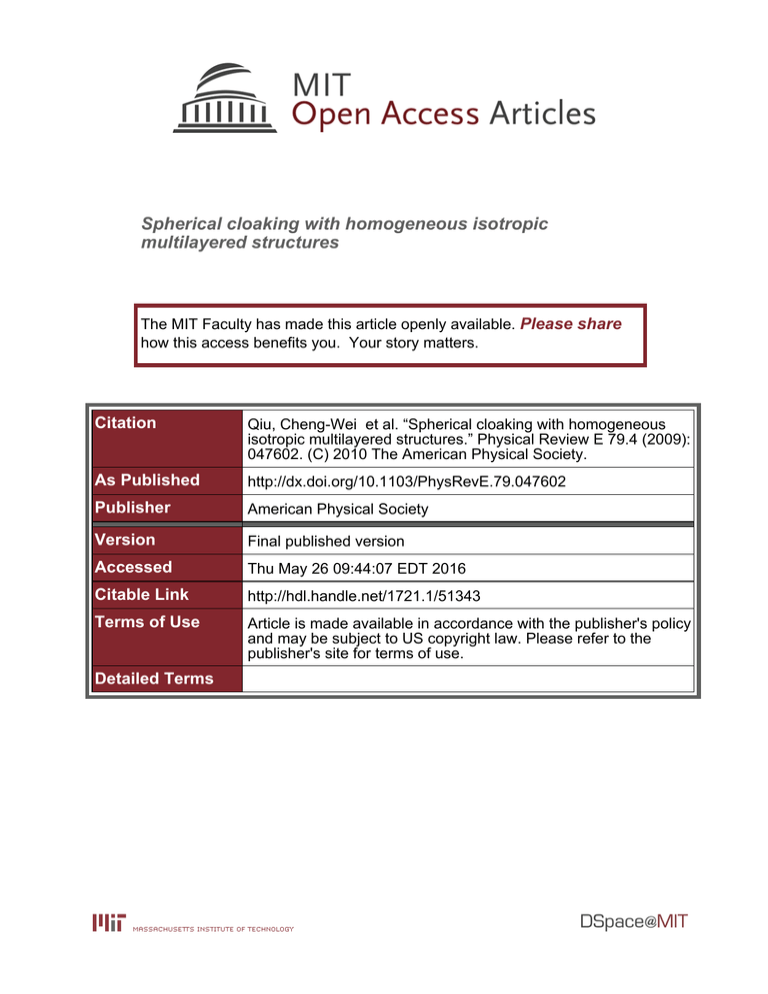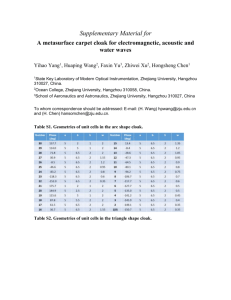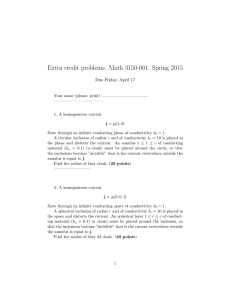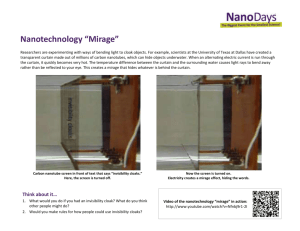Spherical cloaking with homogeneous isotropic multilayered structures Please share
advertisement

Spherical cloaking with homogeneous isotropic multilayered structures The MIT Faculty has made this article openly available. Please share how this access benefits you. Your story matters. Citation Qiu, Cheng-Wei et al. “Spherical cloaking with homogeneous isotropic multilayered structures.” Physical Review E 79.4 (2009): 047602. (C) 2010 The American Physical Society. As Published http://dx.doi.org/10.1103/PhysRevE.79.047602 Publisher American Physical Society Version Final published version Accessed Thu May 26 09:44:07 EDT 2016 Citable Link http://hdl.handle.net/1721.1/51343 Terms of Use Article is made available in accordance with the publisher's policy and may be subject to US copyright law. Please refer to the publisher's site for terms of use. Detailed Terms PHYSICAL REVIEW E 79, 047602 共2009兲 Spherical cloaking with homogeneous isotropic multilayered structures 1 Cheng-Wei Qiu,1,2,* Li Hu,1 Xiaofei Xu,3 and Yijun Feng3 Department of Electrical and Computer Engineering, National University of Singapore, 4 Engineering Drive 3, Singapore 117576, Singapore 2 Research Laboratory of Electronics, Massachusetts Institute of Technology, 77 Massachusetts Avenue, Cambridge, Massachusetts 02139, USA 3 Department of Electronic Science and Engineering, Nanjing University, Nanjing 210093, China 共Received 23 August 2008; revised manuscript received 21 January 2009; published 23 April 2009兲 We propose a practical realization of electromagnetic spherical cloaking by layered structure of homogeneous isotropic materials. By mimicking the classic anisotropic cloak by many alternating thin layers of isotropic dielectrics, the permittivity and permeability in each isotropic layer can be properly determined by effective medium theory in order to achieve invisibility. The model greatly facilitates modeling by Mie theory and realization by multilayer coating of dielectrics. Eigenmode analysis is also presented to provide insights of the discretization in multilayers. DOI: 10.1103/PhysRevE.79.047602 PACS number共s兲: 41.20.Jb, 42.25.Fx, 41.20.⫺q Recently, invisibility cloaks 关1–4兴 have received great attention since Pendry et al. 关5兴 suggested that an object coated by an inhomogeneous anisotropic shell becomes invisible to electromagnetic waves. The electromagnetic wave interaction with such a cloak was analyzed 关6兴. In addition to the common method of geometric transformation, various approaches have been proposed to create invisibility cloaks, such as plasmonic resonances 关7兴, scattering cancellation 关8兴, negative index material 关9兴, and stationary Schrödinger equation 关10兴. Attempts to realize the cloaking idea have been initiated with encouraging results 关11兴. Conventional cloaks need to be anisotropic and their parameters are functions of position. Although this restriction can be bypassed with the simplified material parameters 关11兴, later it was found that the coating established by simplified parameters cannot perfectly shield the targeted object inside without electromagnetic perturbation to external EM fields 关12兴. However, the cylindrical invisibility cloak is still difficult to realize due to the limited resource of natural materials exhibiting radial anisotropy 关13兴, not to mention that those tensorial parameters are spatially varying. In this connection, Cai et al. 关14兴 investigated a multilayered cylindrical cloak by discretizing the conventional position-dependent cloak into many layered coatings, and the material in each layer is position independent but still anisotropic. Huang et al. 关15兴 proposed a cylindrical cloak by replacing one anisotropic coating with a multilayered structure in which each layer is constructed with a certain homogeneous isotropic medium. Some recent works on cylindrical acoustic cloaks were also reported 关16,17兴. When each layer is thin enough, the effective medium theory can be employed to find out the required permittivity for each layer 关18兴. More recently, this idea was further applied to three-dimensional acoustic cloak by multilayered isotropic materials 关19兴. As for electromagnetic spherical invisibility cloaks, material parameters for the perfect cloak are suggested 关5兴: ⑀r = r = b b−a r−a r ⑀ = = ⑀ = = 2 , 共1兲 b , b−a 共2兲 where the cloak occupies the spherical region 共a ⬍ r ⬍ b兲 and its constitutive material parameters are given by 冤 冥 ⑀r 0 0 ⑀ = ⑀0 0 ⑀t 0 , 0 0 ⑀t _ 冤 冥 r 0 0 = 0 0 t 0 , 0 0 t _ 共3兲 ˆ ˆ and the subscripts r where the unit dyad is I = r̂r̂ + ˆ ˆ + and t denote the parameters along radial 共r̂兲 and tangential ˆ 兲, respectively. The anisotropic cloaking direction 共ˆ or proposed by Pendry et al. intrinsically requires the radial parameters 共⑀r and r兲 at the innermost boundary r = a to be zero. Also, the position-dependent anisotropic material is a strict restriction for practical realization. In this Brief Report, we will start from the analysis of eigenmodes in an anisotropic medium and present an alternative way to realize spherical cloaks by a series of layered isotropic materials as shown in Fig. 1, while the cloaking effects are still maintained. Thus, Mie theory can be directly applied to study this multilayered structure instead of tailoring Mie scattering model to consider the radial anisotropy. In Ref. 关20兴, it has been proved that the TE and TM waves are decoupled if off-axis elements are zero, i.e., the uniaxial form as in Eq. 共3兲. The radial components of E and H fields have been derived in a more general case 共the material studied here is only a subset兲. Similarly, if we solve the Maxwell equations with two decoupled scalar Debye potentials 共i.e., ⌽TE and ⌽TM兲 关21兴 and equate the radial components of BTE,TM and DTE,TM, we have 冉 047602-1 冊 ⌽TM 2⌽TM 1 1 ⑀r 2⌽TM + sin + ⑀t r2 r2sin r2 sin2 2 + 20⑀0t⑀r⌽TM = 0, *eleqc@nus.edu.sg 1539-3755/2009/79共4兲/047602共4兲 冉 冊冉 冊 共4兲 ©2009 The American Physical Society PHYSICAL REVIEW E 79, 047602 共2009兲 BRIEF REPORTS ⑀t = ⑀ = ⑀ and t = = 兲. In such cases, the anisotropy ratios become Ae = Am = r2 / 共r − a兲2, and thereby Eqs. 共6兲 and 共7兲 are respectively reduced to 再 冋 n共n + 1兲 2 + k2t − r2 共r − a兲2 册冎 R共r兲 = 0, R共r兲 = 冑kt共r − a兲/2jn关kt共r − a兲兴. FIG. 1. 共Color online兲 Geometries of the proposed spherical invisibility cloak. Parameters of multilayered isotropic coatings are defined in Cartesian coordinates. The superscript p denotes pth layer 共p = 1 , 2 , . . . , 2M兲. The inner core is a perfect electric conductor 共PEC兲 with the radius a = 1 and the outermost radius is b = 2 which are fixed throughout. The thickness of every coated layer is identical, i.e., / 2M. 冉 冊 ⌽TE 2⌽TE 1 1 r 2⌽TE sin + 2 2 2 + 2 t r r sin r sin 2 + 20⑀0r⑀t⌽TE = 0. 共5兲 It can be seen that isotropic case 关22兴 is just a subset. The method of variable separation, where ⌽ = R共r兲T共兲H共兲 is assumed, further leads us to 再 冋 n共n + 1兲 2 2 + kt − Ae,m r2 r 2 册冎 R共r兲 = 0, 共6兲 where kt = k0冑⑀tt, Ae = ⑀t / ⑀r 共electric anisotropy ratio兲, and Am = t / r 共magnetic anisotropy ratio兲. The idea here is to define v1共v1 + 1兲 = n共n + 1兲Ae and v2共v2 + 1兲 = n共n + 1兲Am, so that Eq. 共6兲 can still fall in the domain of classical Mie theory except for a slight modification in the order of Bessel functions. Thus, the radial function can be expressed in terms of Ricatti-Bessel functions R共r兲 = 冑ktr/2jv1,v2共ktr兲, 共7兲 v1 = 冑n共n + 1兲Ae + 1/4 − 1/2 共8兲 v2 = 冑n共n + 1兲Am + 1/4 − 1/2. 共9兲 共11兲 One can see that eigenmodes in position-independent radial anisotropic materials consist of Bessel functions with complex order 共can be any complex values in general兲 while eigenmodes in Pendry’s cloak 关5兴 become integer-order Bessel functions. Thus, it comes to our mind that it is, in principle, possible to utilize many thin spherical layers of isotropic materials to mimic a conventional anisotropic cloak since the characteristics of eigenmodes are basically similar in both situations 共Bessel functions of integer order兲. Thus, at a certain distance r, the position-dependent term 关i.e., kt共r − a兲兴 in the Bessel function of Eq. 共11兲 for Pendry’s cloak can be asymptotically replaced with the term 共i.e., k pr兲 of a Bessel function corresponding to a properly designed isotropic medium. Eventually, the Pendry’s cloak can be well mimicked by multilayered isotropic coatings, if M is big enough. We first discretize the single anisotropic shell into 2M layers with identical thickness, and then the radius of each layer in Fig. 1 could be determined as rp = a + p b−a , 2M p = 1,2, . . . ,2M . 共12兲 The thickness of each layer should be much less than the wavelength, i.e., the number M needs to be sufficiently large. Then the discrete material parameters for each layer can be obtained by substituting Eq. 共12兲 into Eq. 共1兲. Effective medium theory is applied to design parameters of these two types of alternating isotropic layered materials. From Sten’s formula 关23兴, = = 共Ap + Bp兲/2, 1 1 1 = p+ p r 2A 2B where It is clear that the radial anisotropies can be systematically considered in the order of Bessel functions without changing Mie theory for isotropic cases significantly. Since T共兲 and H共兲 are, respectively, associated Legendre polynomials and harmonic functions, we can expand the incident, scattered, and transmitted waves with certain expansion coefficients in terms of those potentials. Those expansion coefficients are to be determined from boundary conditions at each interface, but the derivation is suppressed. An interesting thing arises when the material parameters in Eqs. 共4兲 and 共5兲 are defined by Eqs. 共1兲 and 共2兲, 共i.e., 共10兲 共 = ⑀ or 兲, 共13兲 共14兲 one can obtain the equivalent medium parameters for the isotropic layered structure when the thickness of each layer is identical ⑀Ap = ⑀ − 冑⑀2 − ⑀⑀r , 共15兲 ⑀Bp = ⑀ + 冑⑀2 − ⑀⑀r , 共16兲 Ap = − 冑2 − r , 共17兲 Bp = + 冑2 − r . 共18兲 Both type-A and type-B materials are magnetic materials with nonunity permeability. In contrast to the cylindrical case, material parameters in Eqs. 共1兲 and 共2兲 cannot be per- 047602-2 PHYSICAL REVIEW E 79, 047602 共2009兲 BRIEF REPORTS FIG. 2. 共Color online兲 The real part of electric field Ex on z-x plane for a plane wave polarized in x direction and propagating along z direction. The geometry of the proposed cloaking 共case I兲 has been illustrated in Fig. 1, and the operating frequency is f = 2 GHz. The inset in 共c兲 shows the electric field outside the cloak only. fectly reduced to a nonmagnetic case while the cloaking effects can still be maintained. The simulation results of the proposed cloaking structure 共Case I: PEC-A-B-A-B-……, from inside out; Case II: PECB-A-B-A-……, from inside out兲 illuminated with a plane wave is shown in Fig. 2. Invisibility performance is quite pronounced when the layer number becomes large enough 关e.g., the insets in Fig. 2共c兲 and Fig. 3共c兲 which only show the fields in the region r ⬎ b兴. It can be speculated that the change in the sequence of type-A and type-B materials will have no remarkable impact upon the cloaking effects if the layer number is sufficiently large, which can be verified from the comparison between Figs. 2共c兲 and 3共c兲. However, when we have difficulties to coat so many thin layers which follow the parameter designs in Eqs. 共15兲–共18兲, we have to terminate the coating process at a certain medium value of M FIG. 3. 共Color online兲 The real part of Ex on z-x plane. The geometry of the proposed cloaking 共case II兲 has been illustrated in Fig. 1 except changing the sequence of A-B into B-A from inside out. The operating frequency is f = 2 GHz. The inset in 共c兲 shows the electric field outside the cloak only. considering the fabrication cost and implementation difficulty. Under such circumstances 共e.g., M = 20兲, it is found that, even though the invisibility performance still holds in the region r ⬎ b for both case I 关see Fig. 2共b兲兴 and case II 关see Fig. 3共b兲兴, the peak value of Ex in Fig. 3共b兲 共case II兲 within the cloaking region is smaller than that in Fig. 2共b兲 共case I兲. This will result in lower RCS in the far zone because the cloaked PEC is less “visible.” It is worth noting that the impedances of cases I and II are the same, but case II exhibits better cloaking effects because its refractive index of the outermost layer is closer to that of free space than that in case I. To further demonstrate the capability of the proposed spherical cloakings, we present the bistatic radar cross section 共RCS兲 of the multilayered isotropic structure for cloaking case II in Fig. 4. Mie theory is employed to calculate the bistatic RCS. It can be clearly seen that, when the layer num- 047602-3 PHYSICAL REVIEW E 79, 047602 共2009兲 BRIEF REPORTS FIG. 4. 共Color online兲 Bistatic RCS of the effective cloak 共case II兲 made of multilayered isotropic structures at different numbers of layers. FIG. 5. 共Color online兲 Bistatic RCS of the effective cloak 共case II兲 with the same loss tangent at 0.01 in each layer for different values of M. ber is increasing 共each isotropic layer is thinner兲 and the parameters are properly selected, the far-field scattering of such multilayered isotropic structures dramatically drops compared with that of a bare PEC sphere. It also verifies the validity of the mechanism of the parameter formulation for the proposed spherical cloak. In Fig. 5, we assume the material in every layer has a loss tangent of 0.01 in both permittivities and permeabilities. It shows that the introduction of the loss in respective layer will degrade cloaking effects in the vicinity of zero degree even though the Pendry’s cloak is highly discretized. The far-field quantity will decrease significantly when the angle becomes larger than zero where the cloaking effects are well sustained. In summary, we have proposed an isotropic multilayered structure as an equivalent spherical cloak. The physics of our spherical invisibility cloak has been interpreted in terms of the property of eigenmodes. The discretization with a medium value of M in our design lifts a lot of strict requirements in realizing conventional anisotropic spherical cloaks in which the material needs to be anisotropic and parameters have to be radius dependent. Also, the multilayered isotropic structure can be solved rigorously by Mie scattering model. The design of the proposed cloak with spherically layered isotropic structures has been analyzed and verified, and the cloaking effects are well demonstrated. 关1兴 关2兴 关3兴 关4兴 关5兴 关6兴 关7兴 关8兴 关9兴 关10兴 关11兴 关12兴 关13兴 D. A. B. Miller, Opt. Express 14, 12457 共2006兲. F. Zolla et al., Opt. Lett. 32, 1069 共2007兲. W. Cai et al., Appl. Phys. Lett. 91, 111105 共2007兲. Z. Ruan, M. Yan, C. W. Neff, and M. Qiu, Phys. Rev. Lett. 99, 113903 共2007兲. J. B. Pendry, D. Schurig, and D. R. Smith, Science 312, 1780 共2006兲. H. Chen, B. I. Wu, B. Zhang, and J. A. Kong, Phys. Rev. Lett. 99, 063903 共2007兲. N. A. Nicorovici, R. C. McPhedran, and G. W. Milton, Phys. Rev. B 49, 8479 共1994兲. A. Alu and N. Engheta, Phys. Rev. E 72, 016623 共2005兲. G. W. Milton and N.-A. P. Nicorovici, Proc. R. Soc. London, Ser. A 462, 3027 共2006兲. U. Leonhardt, Science 312, 1777 共2006兲. D. Schurig et al., Science 314, 977 共2006兲. M. Yan, Z. Ruan, and M. Qiu, Phys. Rev. Lett. 99, 233901 共2007兲. C. W. Qiu and B. S. Luk’yanchuk, J. Opt. Soc. Am. A Opt. The authors thank reviewers for bringing several important references to our attention. This work was also partially supported by the National Basic Research Program 共973兲 of China 共Grant No. 2004CB719800兲 and the National Natural Science Foundation of China 共Grant No. 60671002兲. Image Sci. Vis 25, 1623 共2008兲. 关14兴 L. W. Cai and J. Sanchez-Dehesa, N. J. Phys. 9, 450 共2007兲. 关15兴 Y. Huang, Y. Feng, and T. Jiang, Opt. Express 15, 11133 共2007兲. 关16兴 Y. Cheng, F. Yang, J. Y. Xu, and X. J. Liu, Appl. Phys. Lett. 92, 151913 共2008兲. 关17兴 D. Torrent and J. Sánchez-Dehesa, N. J. Phys. 10, 063015 共2008兲. 关18兴 A. A. Govyadinov and V. A. Podolskiy, Phys. Rev. B 73, 155108 共2006兲. 关19兴 Y. Cheng and X. J. Liu, Appl. Phys. A 94, 25 共2009兲. 关20兴 C. W. Qiu, L. W. Li, Q. Wu, and T. S. Yeo, IEEE Antennas Wirel. Propag. Lett. 4, 467 共2005兲. 关21兴 J. Roth and M. J. Digman, J. Opt. Soc. Am. 63, 308 共1973兲. 关22兴 M. Born and E. Wolf, Principles of Optics, 7th ed. 共University Press, Cambridge, 1999兲. 关23兴 J. C. E. Sten, IEEE Trans. Dielectr. Electr. Insul. 2, 360 共1995兲. 047602-4



